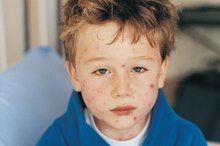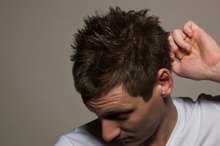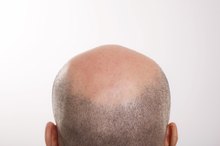What does fact checked mean?
At Healthfully, we strive to deliver objective content that is accurate and up-to-date. Our team periodically reviews articles in order to ensure content quality. The sources cited below consist of evidence from peer-reviewed journals, prominent medical organizations, academic associations, and government data.
- U.S. National Library of Medicine: Medline Plus: Acne
- U.S. National Library of Medicine: Medline Plus: Comedones
- U.S. National Library of Medicine: Medline Plus: Folliculitis
- Pub Med: The Western Journal of Medicine: Itchy Bumps on Back
- Pub Med: The Western Journal of Medicine: Itchy Bumps on Back
- U.S. National Library of Medicine: Medline Plus: Chickenpox
The information contained on this site is for informational purposes only, and should not be used as a substitute for the advice of a professional health care provider. Please check with the appropriate physician regarding health questions and concerns. Although we strive to deliver accurate and up-to-date information, no guarantee to that effect is made.
Red Bumps on the Back
Red bumps on your back may occur with conditions related to your hair follicles 4. Hair follicles cover nearly every part of your body except for you lips, the palms of your hands and the soles of your feet. Red bumps on your back may also be a symptom of an underlying autoimmune disorder 4.
Acne
Acne may cause red bumps on your back 4. Acne occurs when pores on the surface of your skin get clogged. Glands in your skin may produce too much oil and lead to blockages in the pore. These blockages can rupture and cause an inflammatory reaction that produces pimples that look like red bumps on your back. Deep inflammation may cause larger bumps that are called cysts. A more severe form of acne called acne vulgaris may occur on your back and result in comedones. Comedones are small, flesh-colored white or dark bumps that give your skin a rough texture.
- Acne may cause red bumps on your back 4.
- These blockages can rupture and cause an inflammatory reaction that produces pimples that look like red bumps on your back.
Folliculitis
What Causes Blackheads on My Back?
Learn More
Infections like folliculitis occurs when hair follicles on your skin get infected by bacteria or viruses. A folliculitis infection may look like small pimples around several hair follicles 3. Folliculitis bumps may itch and superficial infections may clear within a few days. You can contract folliculitis on your back from exposure to bacteria in hot tubs and jacuzzis.
- Infections like folliculitis occurs when hair follicles on your skin get infected by bacteria or viruses.
Celiac Disease
Autoimmune conditions and diseases such as Celiac disease may produce red bumps on your back known as dermatitis herpetiformis. Celiac disease is a digestive disorder that damages your intestine and interferes with the absorption of nutrients in your food. You are not able to tolerate the protein gluten if you have this disease. Dermatitis herpetiformis is an itchy rash that may form on your back. The rash consists of itchy bumps and blisters that persist over a long period of time 4.
- Autoimmune conditions and diseases such as Celiac disease may produce red bumps on your back known as dermatitis herpetiformis.
Varicella
Pimple-Like Rashes on the Skin
Learn More
Varicella is an infection caused by the varicella-zoster. This is a common childhood infection also known as chickenpox. A child or adult with this condition may develop hundreds of itchy, fluid-filled blisters that burst and form crust. Adult chickenpox are known as shingles. After a case of chickenpox, the virus may remain dormant in your body for the rest of your life and approximately 10 percent of adults experience a subsequent case of shingles during periods of stress.
- Varicella is an infection caused by the varicella-zoster.
- A child or adult with this condition may develop hundreds of itchy, fluid-filled blisters that burst and form crust.
Treatment
Treatment for red bumps on your back depends on your specific condition 4. Consult your health care provider or dermatologist for a diagnosis and treatment recommendations for your specific condition. Acne treatment includes washing your skin with mild, non-drying and non-comedogenic soaps that do not clog your pores. Treatment for folliculitis may include topical antibiotic ointments or antipruritic ointments to help relieve the itching. The only treatment for celiac disease is a gluten-free diet. Treatment for chickenpox may include oatmeal baths and antihistamines to help reduce itching. Antiviral medications may benefit a case of chickenpox if you administer the medication within 24 hours of the first rash.
- Treatment for red bumps on your back depends on your specific condition 4.
- Treatment for chickenpox may include oatmeal baths and antihistamines to help reduce itching.
Related Articles
References
Resources
Writer Bio
Miguel Cavazos is a photographer and fitness trainer in Los Angeles who began writing in 2006. He has contributed health, fitness and nutrition articles to various online publications, previously editing stand-up comedy and writing script coverage as a celebrity assistant. Cavazos holds a Bachelor of Arts in philosophy and political science from Texas Christian University.









